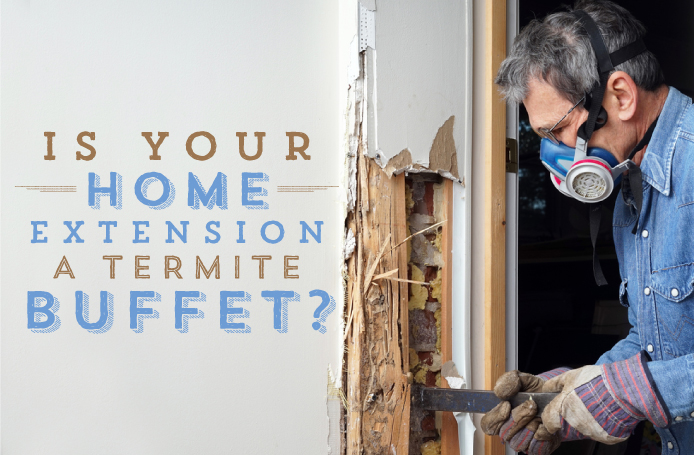Often home extensions aren’t built with the same termite protection as the rest of the house, and so can provide hidden entryways for termites to get into your home. House extensions are high risk building sites for termite attacks because of problems such as: a lack of zone continuity, reduced subfloor ventilation, and restricted subfloor access.
If you are about to build an extension or have just built one then here are some things to keep in mind about termites:
- Of the 350 species of termites in Australia, only six of these actually cause damage to houses (the two most common the White Ant Man gets calls about are Schedorhinotermes and Coptotermes) but all six species of termites attack houses from underground.
- So, it goes without saying that the subfloor of your extension is your most important area to defend against termites. If you get this right, then you’ll have more control over hidden entryways.
- Termites don’t just attack wooden houses either; steel and stone buildings are equally at risk.
How to build an extension with good termite protection:
It’s not realistic to think you can stop termites getting into your extension completely, but there are things you can do to save you from big problems later on. The best thing to do is design your extension to make it easier to inspect by incorporating a termite management system into the construction. Management systems are not designed to prevent termites, but to make them easier to detect. Open and well-ventilated sub-flooring enables crawl access and good surface drainage to keep the area dry. This enables regular inspections to be carried out at predetermined points and any termite activity to be dealt with swiftly.
Some typical termite management systems are:
- Treated timber framing
- Concrete slabs with exposed edges of 75 mm
- Stainless steel mesh or sheet caps for pylons
- Stone covered footings for suspended floors
- Regular chemical applications around footings or slab edges
How to protect your extension from termite attacks:
Once you’ve built your extension with its termite management system, schedule regular inspections at least every 12 months, even more often if you’re in a high-risk area such as near the bush or have damp ground. Avoiding regular inspections can prove costly in the long run if your house insurance doesn’t cover termite damage.
In the meantime, you can help maintain the effectiveness of the management system by ensuring that they are kept clear of any landscaping works, such as garden beds or paving. It’s best to think about this at the start when you’re deciding on what type of management system to use, so it’s not compromised later on.
It is also vital that any porches, stairs, landings and posts on your extension can easily be inspected for termites. Avoid storing items irresistible to termites such as old newspaper, cardboard or firewood under the extension.




